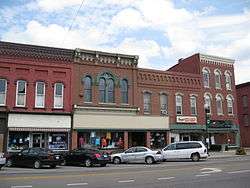Hornell, New York
| Hornell | |
|---|---|
| City | |
|
Downtown Hornell | |
| Nickname(s): Maple City, H-Town, H-Tizzle, Alstomtown | |
 Hornell Location within the state of New York | |
| Coordinates: 42°19′N 77°40′W / 42.317°N 77.667°WCoordinates: 42°19′N 77°40′W / 42.317°N 77.667°W | |
| Country | United States |
| State | New York |
| County | Steuben |
| First settled | 1790 |
| Incorporated (Town of Hornellsville) | 1820 |
| Incorporated (Village of Hornellsville) | 1852 |
| Incorporated (City of Hornellsville/Hornell) | 1888/1906 |
| Government | |
| • Type | (Mayor-Council) |
| • Mayor | Shawn Hogan (D) |
| • City Council |
Members' List
|
| Area | |
| • Total | 2.7 sq mi (7.1 km2) |
| • Land | 2.7 sq mi (7.1 km2) |
| • Water | 0.0 sq mi (0.0 km2) |
| Elevation | 1,161 ft (354 m) |
| Population (2010) | |
| • Total | 8,563 |
| • Density | 3,309.0/sq mi (1,277.6/km2) |
| Time zone | Eastern (EST) (UTC-5) |
| • Summer (DST) | EDT (UTC-4) |
| ZIP code | 14843 |
| Area code(s) | 607 |
| FIPS code | 36-35672 |
| GNIS feature ID | 0975771 |
Hornell is a city in Steuben County, New York, United States. The population was 8,563 at the 2010 census. The city is named after the Hornell family, early settlers. Its current population has not yet been released by the new census.
The City of Hornell is surrounded by Town of Hornellsville. Hornell is about 55 miles south of Rochester and is near the western edge of Steuben County.
Hornell is nicknamed the "Maple City" after the large maple trees that once grew throughout the town and covered the surrounding hills of the Canisteo Valley. Hornell has the largest Saint Patrick's Day parade and celebration in the area, bringing many out to welcome spring and show their green. It has also become a tradition that Mayor Shawn Hogan finds an innovative way of making his way down Main Street on this particular day.
Hornell Municipal Airport (KHTF) is located a few miles north of the city on Route 36. The airport has a hard surface runway capable of landing small jets, a rotating beacon and fuel.
History

What is now Hornell was first settled in 1790 under the name "Upper Canisteo", to distinguish it from the community of Canisteo, then known as "Lower Canisteo". The family of Benjamin Crosby were the first settlers in what is now Hornell. The area was incorporated as a town in 1820, as "Hornellsville." The name comes from early settler George Hornell Jr, who built the first gristmill here.
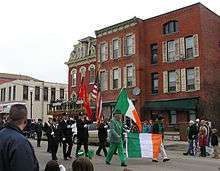
The City of Hornell was chartered in 1888 as the "City of Hornellsville," (having been first organized as the "Village of Hornellsville" in 1852). The name was changed to Hornell in 1906.
Major flooding in 1935 put parts of the city under water, prompting the creation of a system of levees to prevent future serious flooding issues.
The former city park, Union park, was destroyed by the urban renewal of the 1970s.
In 1950, Hornell had a population near 16,000 people. It had two radio stations, WWHG and WLEA, and three movie theaters, the Steuben and the Majestic, located on Broadway, and the Hornell, located on Main Street.
The current mayor of Hornell is Democrat Shawn Hogan, who has held the position since January 1986.[1] Hogan is the longest-serving current mayor in New York State.
In 2009 Kirk W. House produced Around Hornell, a historic photo book in Arcadia Publishing's "Images of America" series. Around Hornell also includes the surrounding rural communities of Canisteo, Dansville, Fremont, Hartsville, Hornellsville, and Howard.
The Hornell Armory, Hornell Public Library, Adsit House, Lincoln School, St. Ann's Federation Building, and United States Post Office are listed on the National Register of Historic Places.[2][3]
Railroads and Hornell
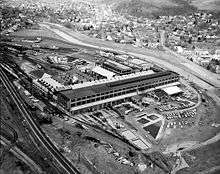
The New York and Erie Railroad arrived in Hornell in 1850, which connected New York City and Dunkirk on Lake Erie via a Southern Tier route. Another route, the Buffalo and New York City Railroad, was added in 1852, branching from Hornell northwestward to Buffalo. For the next hundred years Hornell enjoyed prosperity with its steam engine shop doing the repairs for the entire Erie railroad line. In 1960 Erie merged with the Lackawanna, the Hornell repair shop was closed, and repair operations were consolidated at the Lackawanna's Scranton facility. The railroad then came upon hard times as trucking picked up more and more of the freight business. In 1972, the line filed for bankruptcy. Just a few days later floods from Hurricane Agnes destroyed about 200 miles (320 km) of roadbed along the Canisteo River, removing all hope of reoperating the railroad line south of Hornell.
Passenger service, in severe decline, ended completely by 1960.
Hornell has today (2014) half the population it had in 1960. As the population dropped businesses closed; civic institutions such as churches were also affected.

Hornell has struggled to regain its former prosperity. The former Erie shops are now Alstom's main North American assembly and manufacturing site for the production of AC traction motors, railway cars, and passenger locomotives. Car bodies are shipped disassembled from São Paulo, Brazil and assembly into cars takes place in Hornell. Prior to Alstom, the shops were operated by Morrison Knudsen. After a difficult period Alstom Transport won a contract worth $194 million USD to execute the complete overhaul of Philadelphia's Port Authority Transit Corporation (PATCO) light rail fleet, beginning in 2011.[4] In 2013, the Alstom facility was contracted to build 34 light rail vehicles for delivery to Ottawa by 2018.[5]
Highway construction
Route 36 Arterial
Hornell's central layout was changed significantly by the construction of the New York Route 36 arterial in the 1970s. Prior to that, Route 36, Hornell's main north-south highway, was routed along Seneca Street (to the north) and Canisteo Street (to the south). Neither of these streets was adequate for the increased automobile and truck traffic which accompanied the decline of the railroad, and they could not be easily expanded; Canisteo Street also had a significant bottleneck where the route went under the Erie Railroad tracks, just south of downtown. Route 36 between Hornell and Canisteo, also inadequate, could not be expanded due to the adjacent Canisteo River. The decision was made to replace the route with an arterial, west of Seneca Street on the north side, crossing the downtown and exiting Hornell east of Canisteo Street on the south side. The four-lane route was continued to Canisteo, at a higher and geographically better location than the old route. Unconnected fragments of the former Route 36 from Hornell to Canisteo survive; in Hornell it starts from East Avenue, east of the river, and in the Town of Canisteo it is today McBurney Road.
The impact of the relocation of Route 36 on central Hornell was profound. Much of the south end of the downtown was destroyed. Seneca Street and Broadway, formerly important commercial streets, became deserted. Part of the city's central park (Union Park) was taken for the highway, with the remainder paved to create public parking lots. Canisteo Street became unconnected at both ends.
The Southern Tier Expressway (New York Route 17, now Interstate 86)
When the decision was made in the 1960s to upgrade the western portion of New York Route 17 to expressway status, it was decided to route the expressway through the Hornell area, as it was considered to have more prospects for development than Greenwood and Jasper, along the old route (now New York Route 417). Interstate 86 crosses Route 36 between Hornell and Arkport. It is today Hornell's main highway.
Geography
Hornell is located at 42°19′N 77°40′W / 42.317°N 77.667°W (42.3244, -77.6603).[6] Hornell is at an altitude of 1,160 feet (354 meters) above sea level.
According to the United States Census Bureau, the city has a total area of 2.7 square miles (7.0 km2), all of it land.
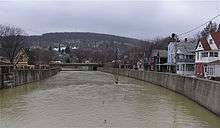
Hornell is on the Canisteo River and surrounded by the foothills of the Allegheny Mountains.
New York State Route 21 conjoined with New York State Route 36 passes through the city, which is just south of the Southern Tier Expressway (Interstate 86 / New York State Route 17). County Roads 65, 68 and 109 also lead into the city.
The City is served by two railroads - it is on the Norfolk Southern's Buffalo-East Coast mainline and is the eastern terminus of the mainline of the Western New York and Pennsylvania Railroad.
Demographics
| Historical population | |||
|---|---|---|---|
| Census | Pop. | %± | |
| 1870 | 4,552 | — | |
| 1880 | 8,195 | 80.0% | |
| 1890 | 10,996 | 34.2% | |
| 1900 | 11,918 | 8.4% | |
| 1910 | 13,617 | 14.3% | |
| 1920 | 15,025 | 10.3% | |
| 1930 | 16,250 | 8.2% | |
| 1940 | 15,649 | −3.7% | |
| 1950 | 15,049 | −3.8% | |
| 1960 | 13,907 | −7.6% | |
| 1970 | 12,144 | −12.7% | |
| 1980 | 10,234 | −15.7% | |
| 1990 | 9,877 | −3.5% | |
| 2000 | 9,019 | −8.7% | |
| 2010 | 8,563 | −5.1% | |
| Est. 2015 | 8,336 | [7] | −2.7% |
As of the census[9] of 2000, there were 9,019 people, 3,596 households, and 2,218 families residing in the city. The population density was 3,309.0 people per square mile (1,275.6/km²). There were 4,100 housing units at an average density of 1,504.2 per square mile (579.9/km²). The racial makeup of the city was 95.73% White, 2.38% African American, 0.23% Native American, 0.57% Asian, 0.04% Pacific Islander, 0.38% from other races, and 0.67% from two or more races. Hispanic or Latino of any race were 1.29% of the population.
There were 3,596 households out of which 32.4% had children under the age of 18 living with them, 40.9% were married couples living together, 16.1% had a female householder with no husband present, and 38.3% were non-families. 32.0% of all households were made up of individuals and 14.3% had someone living alone who was 65 years of age or older. The average household size was 2.44 and the average family size was 3.07.
In the city the population was spread out with 27.7% under the age of 18, 9.7% from 18 to 24, 27.0% from 25 to 44, 19.7% from 45 to 64, and 16.0% who were 65 years of age or older. The median age was 35 years. For every 100 females there were 89.0 males. For every 100 females age 18 and over, there were 82.9 males.
The median income for a household in the city was $28,184, and the median income for a family was $35,000. Males had a median income of $31,727 versus $18,854 for females. The per capita income for the city was $14,419. About 18.7% of families and 21.4% of the population were below the poverty line, including 32.1% of those under age 18 and 6.6% of those age 65 or over.
Parks and recreation
There are several parks in the city of Hornell including:
- Maple City Park is adjacent to the Hornell High School and is maintained by both the school district and the city. It includes tennis courts, a baseball field, softball field, multiple half-basketball courts, a playground, a 6-lane rubber track, and a turf field (football and soccer). It is the home of the Hornell Dodgers NYCBL baseball team and the Hornell Red Raider athletic teams. Hornell's annual "Music Under the Stars" drum and bugle corps event also takes place on the turf field at this site.
- Veterans Memorial Park at James Street (formerly known as simply James St. Park) has many sports fields, pavilions, the city pool, and several playgrounds. 4 July celebrations, including fireworks, are located at this park.
- Michael C. Fucci Memorial Park at Shawmut is where the Hornell skate park is located. Many youth football and baseball games are also played on the fields. There was, at one time, an effort for Rails to Trails to create a bike/hike trail from this park northwestward.
Education
There are five public schools and one private school located in Hornell.
Public schools include:
- Hornell High School (grades 7-12)
- Intermediate School (grades 3-6)
- Bryant School (grades PK-2)
- North Hornell School (grades PK-2)
- Columbian School (Admin. Office & HeadStart)
(The North Hornell School is physically located in the village of North Hornell, but is still a part of the Hornell City School District).
Private Schools:
- St. Ann's Academy is an independent Catholic school serving grades PreK - 6. It opened in 2012 after St. Ann's School was closed by the Diocese of Rochester.
- St. Anns Catholic School (grades K-8) [now closed]
The current Superintendent of Schools is Douglas Wyant Jr. In June 2007 the Hornell Evening Tribune newspaper announced that a school planning committee is proposing a $100,000,000.00 project to re-organize the schools and improve assessment results.
The NY School Report Card for the Hornell City School District can now be found at the NYSTART site.
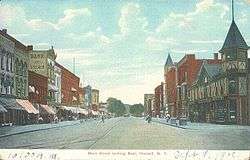
Transportation
Hornell is served by buses operated by Hornell Area Transit.[10]
Notable people
- Gene Burns (1940-2013), Talk radio host
- Bob Crane (1928-1978), actor
- Bill Dugan (Born 1959), professional football player
- Frank Kelly Freas (1922-2005), science fiction artist
- John Keel (1930-2009), author
- Carl Marino, actor
- Bob Morton, Washington state legislator
- Thomas Murphy (1915-2006), CEO of General Motors (1974-1980)
- Bill Pullman (Born 1953), actor
- Vice Adm. Lyndon Spencer, U.S. Coast Guard officer
- Mike Waufle, professional football coach
- Jimmy Wachter (Born 1964), actor
Media
- Radio
References
- ↑ "City of Hornell Mayor's Office". Retrieved 2008-09-30.
- ↑ National Park Service (2009-03-13). "National Register Information System". National Register of Historic Places. National Park Service.
- ↑ "National Register of Historic Places Listings". Weekly List of Actions Taken on Properties: 11/16/15 through 11/20/15. National Park Service. 2015-11-27.
- ↑ "PATCO's entire metro fleet to be modernised between Philadelphia and Southern New Jersey" (Press release). Alstom. 07/02/2011. Retrieved 2013-06-16. Check date values in:
|date=(help) - ↑ Vantuono, William C. (February 14, 2013). "Alstom finalizes Ottawa LRT contract". Railway Age. Simmons-Boardman Publishing Inc.
- ↑ "US Gazetteer files: 2010, 2000, and 1990". United States Census Bureau. 2011-02-12. Retrieved 2011-04-23.
- ↑ "Annual Estimates of the Resident Population for Incorporated Places: April 1, 2010 to July 1, 2015". Retrieved July 2, 2016.
- ↑ "Census of Population and Housing". Census.gov. Retrieved June 4, 2015.
- ↑ "American FactFinder". United States Census Bureau. Retrieved 2008-01-31.
- ↑ http://www.hatrides.com/
External links
| Wikisource has the text of the 1911 Encyclopædia Britannica article Hornell. |
- City of Hornell, New York
- Hornell Area Chamber of Commerce
- Hornell City School District
- Photos and information about Hornell
- St James Mercy Hospital - home - Hornell NY
